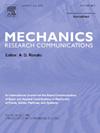中空纤维周期性微极性弹性结构的有效响应
IF 2.3
4区 工程技术
Q3 MECHANICS
引用次数: 0
摘要
本文采用双尺度渐近均匀化方法研究了含中空纤维的周期性微极性弹性结构的有效行为。微极性弹性结构模型为两相单轴纤维增强复合材料(FRC),由各向同性、中心对称的微极性基体和周期性排列的中空纤维定义。在考虑反平面应变变形状态的微极弹性框架内建立了控制方程。阐述了由AHM导出的反平面局部问题,并推导出相应的有效刚度和扭矩特性的显式表达式。分析了中空纤维的空间分布对整体有效性能的影响。得到了中空纤维嵌入复合泡沫和致密聚氨酯泡沫基质中不同平行四边形排列的数值结果。研究结果显示了微观结构对复合材料有效行为的影响,并为改善力学性能的微极性弹性复合材料的设计和优化提供了见解。本文章由计算机程序翻译,如有差异,请以英文原文为准。
Effective response of periodic micropolar elastic structures with hollow fibers
In this work, the effective behavior of periodic micropolar elastic structures with hollow fibers is investigated using the two-scale asymptotic homogenization method (AHM). The micropolar elastic structures are modeled as a two-phase uniaxial fiber-reinforced composite (FRC) defined by an isotropic and centro-symmetric micropolar matrix with periodically arranged hollow fibers. The governing equations are formulated within the micropolar elasticity framework, considering antiplane-strain deformation states. The antiplane local problems derived from AHM are stated, and explicit formulations are derived for the corresponding effective stiffness and torque properties. The influence of the spatial distribution of hollow fibers on the overall effective properties is analyzed. Numerical results are obtained for different parallelogram arrays of hollow fibers embedded in syntactic foam and dense polyurethane foam matrices. The findings show the effect of microstructure on the effective behavior of the composite and provide insight into the design and optimization of micropolar elastic composites with improved mechanical properties.
求助全文
通过发布文献求助,成功后即可免费获取论文全文。
去求助
来源期刊
CiteScore
4.10
自引率
4.20%
发文量
114
审稿时长
9 months
期刊介绍:
Mechanics Research Communications publishes, as rapidly as possible, peer-reviewed manuscripts of high standards but restricted length. It aims to provide:
• a fast means of communication
• an exchange of ideas among workers in mechanics
• an effective method of bringing new results quickly to the public
• an informal vehicle for the discussion
• of ideas that may still be in the formative stages
The field of Mechanics will be understood to encompass the behavior of continua, fluids, solids, particles and their mixtures. Submissions must contain a strong, novel contribution to the field of mechanics, and ideally should be focused on current issues in the field involving theoretical, experimental and/or applied research, preferably within the broad expertise encompassed by the Board of Associate Editors. Deviations from these areas should be discussed in advance with the Editor-in-Chief.

 求助内容:
求助内容: 应助结果提醒方式:
应助结果提醒方式:


